RAF Calshot

Information
RAF Calshot
Details
RAF Calshot, Hampshire has no hard runways, no perimeter track but lots of hangars and it was a very important seaplane base, where aircraft & sea craft were tested, trained, operated & raced.
Calshot opened for the Royal Naval Air Service in 1913. It expanded rapidly with WW1 and had many hangars built on the Spit. The Spit was the operational side and inland a large camp for the personnel. 1917 Calshot was a Flying Boat Station and then by 1918 it became 210 TDS (Training Depot Station). This comprised of Float Seaplane, Aerial
Gunnery & Bomb Dropping School and The Boat Seaplane School. August 1918, 345 & 346(FB) Flights were stationed here, they were operating the CurtissH.12 and Felixstowe flying boats. Mostly used on anti-submarine patrols.

RAF Calshot

Felixstowe F.2. The dazzle feature on this plane was only used on planes at Felixstowe and Great Yarmouth, to frighten the life out of the enemy and also to distinguish between friend and foe.

CurtissH.12. The Felixstowe was the British built version.
RAF Calshot
Google
Information
RAF Calshot
Details
RAF Calshot

2023
Information
RAF Calshot
Details
A nice sunset.

RNAS boat & plane crews.

Plane crew.
RAF Calshot


Record Site Plan 1091/45
Information
RAF Calshot
Details
Two camps Top Camp, "Eaglehurst Camp" Accommodation and Bottom Camp, "The Spit" operational.
Eaglehurst Camp
A very large camp, mostly concrete block construction hutting and quite a lot of married quarters from WW1 to the 1930's & the n the 1950's
1 Officers Mess (for 102) PB & CB.
10 Education Rooms CB.
11 Engine Shed CB.
12 Dinning Room CB.
14 Sergeants Mess CB.
27 Latrines Airmen CB.
34 Institute CB.
36 Coal & Coke Yard CB.
53a-b-c Quarters Married Airmen PB 312-3/22.
58/59 Quarters Married Officers PB 160/21.
60 Quarters Married Officers PB 79/33.
61 Quarters Married Officers PB CA/18.
62 Sewage catch pit W 1680/18.
73
Guard House.
121
Engine House PC.
PB - Permanent Brick. CB - Concrete Block. PC - Permanent Concrete. T - Timber.
/18 = 1918, /22 = 1922, etc.

RNAS wooden hut from WW1.

Huts before they were removed.

Air photo of the Officers Mess.
RAF Calshot

IWM 1917
Information
RAF Calshot
Details
The basic layout and huts were kept right up until the end. This camp was built very much as a permanent site, as most buildings were made of concrete block or permanent brick and most of the married quarters are still in use today as private housing.

Officers Mess drinks.
RAF Calshot

NARA Post WW2
Information
RAF Calshot
Details
A good aerial view of the camp.
RAF Calshot
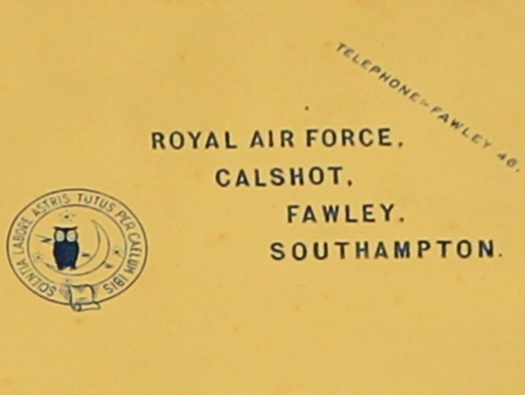
Information
RAF Calshot
Details
Scientia labore tutus per caelum ibis.
Knowledge work safely go through the sky
RAF Calshot

Google
Information
RAF Calshot
Details
Air-raid shelter
On the left of this track it looks like an air-raid shelter from WW2 and the buildings on the right seem to be of wooden construction and could have been temporary hutting for the camp from WW2.

Plan.
RAF Calshot

Google
Information
RAF Calshot
Details
Married Quarters
Tristan Close part of the RAF married quarters with everything a married man needs. Beds, dinning room furniture, knives, forks, spoons and even bedding would be supplied out of central stores. The down side is, if you damaged anything, you had to pay for it. These houses airmen´s married quarters possibly PB D.F.W.73/13. Based o a 1913 drawn plan.
Tristan Close - why Tristan, well a small island in the south Atlantic called Tristan De Cunha has a volcano and it erupted in 1961 and the islanders were evacuated to Calshot camp as it was by then empty. They were allowed to use the houses and huts until they all returned by 1963. Although I believe one lady is/was still living here.

Tristan De Cunha.

Tristan De Cunha families arriving in England.

Hampshire helped the Islanders build a harbour and its now called Calshot Harbour.

The high council of Tristan De Cunha.

A book on the disaster.
RAF Calshot

Google
Information
RAF Calshot
Details
These married quarters were built post war (1950's) and they now are all in private homes.

Plan.

Families party.

RAF Uxbridge married quarters.
RAF Calshot

2006
Information
RAF Calshot
Details
9 - Church - CB.
Still a church today.

Plan.

Church.
RAF Calshot

2006
Information
RAF Calshot
Details
Eaglehurst Camp

Plan.

The old main gate.
RAF Calshot

2006
Information
RAF Calshot
Details
Eaglehurst Camp soon to be a cemetery, if the planners have their way.
 Plan.
Plan.
RAF Calshot



Google Earth 1999 ---------------------------------------------------------- 1987
Information
RAF Calshot
Details
1 - Officers Mess (for 102) - PB & CB.
This was a lovely building, later on it was a public house and we ate a really nice sausage and mash dinner there. Now wish I had taken loads of photos inside. It was a typical Mess building with lots of small rooms where snooker could be played and another for reading and then another for eating and of course a bar area. Some will tell you there was no bar in an RAF Mess as you asked the Mess servant to get your drinks.
1987 the Officers Mess but in 1987 as the Owl & Crescent Hotel.
And towards the end. Very sad.

RAF bell box, if you pressed a bell button in you room, the panel would light up and a servant would see what the officer needed.

Mess servant.

Officers Mess.
RAF Calshot

2006
Information
RAF Calshot
Details
Married Quarters 53, 53A & 53B Married Quarters PB 512-3/22.
Three blocks of remaining 1922 married quarters.

Plan.
RAF Calshot

Google
Information
RAF Calshot
Details
53, 53A & 53B - Married Quarters - PB 512-3/22.
Three blocks of remaining 1922 married quarters.

Plan.
RAF Calshot

2006
Information
RAF Calshot
Details
121 - Engine House
- PC
In here would have been two large diesel engines to be able to power the camp if the mains electric was temporarily disrupted.
RAF Calshot

18 April 2019
Information
RAF Calshot
Details
121 - Engine House
- PC

Plan.

Armoured cable.
RAF Calshot

2006
Information
RAF Calshot
Details
121 - Engine House
- PC
Steel shutters on the windows to protect the building from a close bomb explosion. This building is called a protected type, so is slightly hardened to give it some protection from bomb blast.
RAF Calshot

2006
Information
RAF Calshot
Details
121 - Engine House
- PC
Inside two engine beds.

Two standby set generators.
RAF Calshot

2006
Information
RAF Calshot
Details
I121 - Engine House
- PC
Inside two engine beds and rooms off to the right side.
RAF Calshot

2006
Information
RAF Calshot
Details
121 - Engine House
- PC
Now this is interesting, this engine house was not only protected building as in from a close bomb blast, but also defended. It has rifle embrasures in at least two sides. And then there are the armoured shutters on the windows.

A soldier at a pillbox embrasure.

Lee-Enfield .303 rifle.
RAF Calshot

2006
Information
RAF Calshot
Details
T121 - Engine House
- PC
The second rifle embrasure.
RAF Calshot

2006
Information
RAF Calshot
Details
Lewis gun AA gun position
This small mound was used as a Lewis gun AA gun position.

Anti aircraft Lewis gun.

Anti aircraft Lewis gun.

Plan.
RAF Calshot

2006
Information
RAF Calshot
Details
Lewis gun AA gun position
There would have been a ring of sand bags to give the gunner some protection.

Bren gun position.
RAF Calshot

2006
Information
RAF Calshot
Details
Lewis gun AA gun position
The support for the gun.

Lewis gun mount.
RAF Calshot

2006
Information
RAF Calshot
Details
In the 1920's the RAF Maritime Craft development and training unit was stationed here.
RAF Calshot

Google
Information
RAF Calshot
Details
70 - Projector PC.
73 - Guard House.
These two buildings were the guard house and the seating area the projector (search light).

Search light.

Plan.
RAF Calshot

Google
Information
RAF Calshot
Details
Now we continue up the Spit. The railway ran on the far side of the water, the long mound.

Plan.
RAF Calshot

Int
Information
RAF Calshot
Details
The Calshot Express.
This 2´ 0” gauge steam locomotive No 1431 was built by Andrew Barclay Ltd, Kilmarnock, the order which was placed in 1917 by the Admiralty. For use by the Air Service Construction Corp in Feb 1918, delivery was made and it was first put to work at RAF Manston, Assisting with the construction of an underground hangar. In 1921 it then was transferred to RAF Calshot where it operated on the Calshot line between the sea plane station and Eaglehurst barracks for the Air Ministry Works Dept as their No 1. This train became known as the “Calshot Express”.

Wren.

Wren.
RAF Calshot

2006
Information
RAF Calshot
Details
57788 No 6 Douglas now at the Talyllyn Railway 0-4-2WT
RAF Calshot

2006
Information
RAF Calshot
Details
The Spit, Bottom Camp
3 A.M.W.D. Office PB 107. Air Ministry Works Department.
5 Detonator Store CB.
7 Machine Gun Range PC.
10 Dining Room & Institute PB CA/224.89.
13 Barrack Block 4 NCO's & 70 A/M PB.
14 Transport Shed & Marine Store St 169.
16 Decontamination Centre Type 'J' PB
1096/39 - 1097/40.
22
'G' Shed Aeroplane Repairs, Office & Store St.
24 Power House CB.
33 'A'
Shed, Dope Shop, & Drying Room T&W.
35 Carpenters Shop T&Ci
.
36 Gun Turret Instructional Building St. 177722/39.
50 Technical Store T&Ci 31611/13.
63
Compass Platform T.
64 Slipway PC CAL501.
65 Pier PC &T.
66 Pump House Fire T.
67 'E' Shed Office & Drying Rooms T&Ci 14451.
68
Petrol Pump House Demolished St&Ci.
69 Petrol Meter House & Tanks 3-No. 10,000gal. PC&Sc.
70 Castle, Camera Obscurer & Telephone Exchange. Stone.
71 Gangway 'A' [Duty Look out Shelter] PC.
72 Slipway PC Cal531.
73 Gangway B PC.
76 'H' Shed Pilots Room etc St & AsB.
77 'F' Shed & Offices.
St - steel. AsB - Asbestos. T - Tin.
PC - Permanent Concrete. Ci - Corrugated Iron. W - Wood.

RNAS.

RNAS pilot Anthony Mantle.
RAF Calshot


1913 ------------------------------------------------------------------------------ 1917
Information
RAF Calshot
Details
The Spit, Bottom Camp
This is how Calshot Spit looked at the start in 1913, one [E shed 67 on plan] ARS and the 50 Sopwith ARS shed and three side by side sheds. Bell tents for air & ground personnel to live in. The old battery with four of the Victorian guns and two later WW1 guns. Then by 1917 all the batteries were completely removed and a very large triple [H shed 76 on plan.] linked type 'F' Admiralty Seaplane Sheds were built.
The Hangars (Sheds as they were called) were lettered A,E,H,F,G, etc.
The large triple shed being built.

F Shed.

E Shed.

G Shed.

Sopwith Baby.

Sopwith Bat Boat 1912/1914.
RAF Calshot

Information
RAF Calshot
Details
The Spit, Bottom Camp
5 Detonator Store CB. is the first building you can see and its still there today used by a boat yard.
7 Machine gun range PC 121, now removed .
10 Dining Room & Institute PB CA/224.89. has been removed.
13 Barrack Block 4 NCO's & 70 A/M PB. which is still here.
14 Transport Shed & Marine Store St 169. which makes the point that they used a lot of Motor Transport.

Sopwith Schneider.

WW1 artist Algernon Black seaplane RNAS.

RFC Crossley tender leading a convoy of RFC vehicles.
RAF Calshot

2006
Information
RAF Calshot
Details
Looking back along the Spit.
The RAF's High-speed Flight in the late 1920s and early 1930s were based here for the Schneider Trophy Races and 480 Coastal Reconnaissance Flight using Supermarine Southampton´s flew from here.

Supermarine Southampton.

Supermarine Stranraer. Also London´s, Scapa and Singapore were used in this period.
RAF Calshot

2006
Information
RAF Calshot
Details
18 - Lecture Block & Instructional Room - PB - 1696/39 1097/40 I think? (the plan is not very clear)
RAF Calshot

2006
Information
RAF Calshot
Details
Lecture Block
The HSF were here on the run up to the races, where ever they were to be held.
The Coupe d'Aviation Maritime Jacques Schneider, commonly called the Schneider Trophy or Schneider Prize, was a trophy awarded annually (and later, biennially) to the winner of a race for seaplanes and flying boats. The Schneider Trophy is now held at the Science Museum, South Kensington, London.
Announced in 1912 by Jacques Schneider, a French financier, balloonist and aircraft enthusiast, the competition offered a prize of £1000. The race was held twelve times between 1913 and 1931. It was intended to encourage technical advances in civil aviation but became a contest for pure speed with laps over a (usually) triangular course (initially 280 km, later 350 km). The contests were staged as time trials, with aircraft setting off individually at pre-agreed times, usually 15 minutes apart. The contests were very popular and some attracted crowds of over 200,000 spectators. An earlier trophy, also presented by Jacques Schneider in 1910, in France, was the Schneider Cup, which is now in the possession of the RAF College Cranwell.
If an aero club won three races in five years, they would retain the trophy and the winning pilot would receive 75,000 francs for each of the first three wins. Each race was hosted by the previous winning country. The races were supervised by the Fédération Aéronautique Internationale and the aero club in the hosting country. Each club could enter up to three competitors with an equal number of alternatives.
The race was significant in advancing aeroplane design, particularly in the fields of aerodynamics and engine design, and would show its results in the best fighters of World War II. The streamlined shape and the low drag, liquid-cooled engine pioneered by Schneider Trophy designs are obvious in the British Supermarine Spitfire, the American North American P-51 Mustang, and the Italian Macchi C.202 Folgore.
The Schneider Trophy is a sculpture of silver & bronze set on a marble base. It depicts a zephyr skimming the waves, and a nude winged figure is seen kissing a zephyr recumbent on a breaking wave. The heads of two other zephyrs and of Neptune, the god of the Sea, can be seen surrounded by octopus and crabs. The symbolism represents speed conquering the elements of sea and air.
Wiki.

Jacques Schneider was a French industrial manager, licensed plane and balloon pilot, and, for a long time, held the balloon altitude record (33,074 ft.). Deprived of flying due to a serious accident, he supported various competitions and aero clubs financially

Schneider trophy medal 1927 obverse.
RAF Calshot

2006
Information
RAF Calshot
Details
18 - Lecture Block & Instructional Room - PB - 1696/39 1097/40 I think? the plan is not very clear so some of the numbers and details are very obscure.

Plan.

Sunderland crew.

Erks under instruction.
RAF Calshot

2006
Information
RAF Calshot
Details
5 - Detonator Store - CB.
This building would have had an earth berm around it and an entrance was made of block and a brick cover added in WW2.

Original photo with the rifle range..

Plan.

Fuze detonators.
RAF Calshot

2006
Information
RAF Calshot
Details
5 - Detonator Store - CB.
This building would have had an earth berm around and the entrance was made of block and a brick cover added in WW2.

RFC Fuze instruction.
RAF Calshot

2006
Information
RAF Calshot
Details
5 - Detonator Store - CB.
Concrete blocks were used to allow an access into the store but by WW2 a brick rendered overhead was added so maybe the earth berm was increased in size.
RAF Calshot

2006
Information
RAF Calshot
Details
The top end of the Spit.

Plan.
RAF Calshot

2006
Information
RAF Calshot
Details
13 - Barrack Block 4 NCO's & 70 A/M - PB.
4 NCO's would have their own individual rooms and the men would be in four large barrack dormitories.

Plan.
RAF Calshot

2006
Information
RAF Calshot
Details
13 - Barrack Block 4 NCO's & 70 A/M - PB.
Lawrence was here for a short time as Clerk to the CO of RAF Mount Batten and did a lot of interesting and important work with helping to design fast marine craft to be used as Air Sea Rescue and fast tenders to go out to landing seaplanes and help them in. One other job for fast boats was to drive along the aircraft Trots ( a Trot is a runway on the water for sea planes) to make sure there are no foreign objects in the water to damage the planes.

High speed launch.

Seaplane tender.

RAF dingy.
RAF Calshot

2006
Information
RAF Calshot
Details
13 - Barrack Block 4 NCO's & 70 A/M - PB.
RAF Calshot

2006
Information
RAF Calshot
Details
13 - Barrack Block 4 NCO's & 70 A/M - PB.
Dated 1935.
RAF Calshot

2006
Information
RAF Calshot
Details
13 - Barrack Block 4 NCO's & 70 A/M - PB.
Looking back.
RAF Calshot

2006
Information
RAF Calshot
Details
17 - Lecture Room & Instruction Room - PB - 1633 building.
This is the rear of the Lecture Room which is interesting that it is orientated towards the sea.

Plan.
RAF Calshot

2006
Information
RAF Calshot
Details
17 - Lecture Room & Instruction Room - PB - 1633 building.
The front face looking over the sea.
RAF Calshot

2006
Information
RAF Calshot
Details
17 - Lecture Room & Instruction Room - PB - 1633 building.
Another nice dated block.
RAF Calshot

2006
Information
RAF Calshot
Details
76 - 'H' Shed - a Type 'F' seaplane shed - St & AsB St -Steel, AsB - Asbestos sheeting.
We now come to No.76 a triple 'F' type shed. A three bay Type 'F' seaplane sheds, the RFC/RAF named their hangars sheds until about 1940 mostly with a letter prefix.
There is a little problem with the plan, the hangars are lettered as in E, F, H, etc. But the RAF also named their sheds (hangars) with letter suffixes. That makes naming shads very complicated so please bear with me here.
RAF Calshot

2006
Information
RAF Calshot
Details
76 - 'H' Shed - a Type 'F' seaplane shed - St & AsB
A triple Type 'F' Admiralty Seaplane Shed built in 1917.

Plan.

Camel seaplane.

Catalina.
RAF Calshot


2006 ------------------------------------------------------------------- 1933
Information
RAF Calshot
Details
76 - 'H' Shed - a Type 'F' seaplane shed - St & AsB
The very large door that later on a Sunderland flying boat would fit in but originally built for twin engined seaplanes.
Supermarine Southampton Mk II at Calshot.

Sunderland pilot.

Sunderland cockpit.

Inside a Sunderland.
RAF Calshot
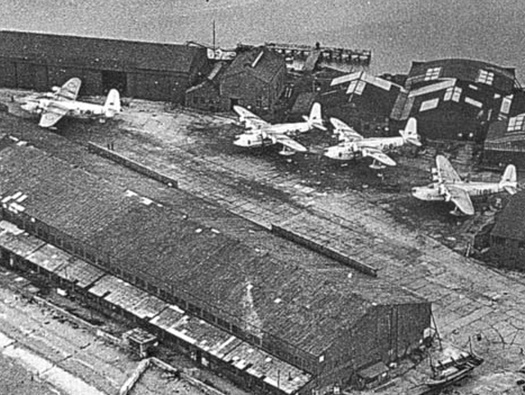
1940's
Information
RAF Calshot
Details
76 - 'H' Shed - a Type 'F' seaplane shed - St & AsB
Four Sunderland's outside the hangar in the 1940's.

Attacking a submarine.

Engine change on water.

Bristol radial engine.
RAF Calshot

2006
Information
RAF Calshot
Details
76 - 'H' Shed - a Type 'F' seaplane shed - St & AsB
Between the slipway and the large 'H' shed was, 22 'G' Shed Aeroplane Repairs, Office & Store St.
This was also a single Type 'F' Admiralty Seaplane Shed.

This is roughly where it would have been where a 'G' Shed sat.

22 'G' Shed Aeroplane Repairs, Office & Store St.
RAF Calshot

2006
Information
RAF Calshot
Details
'76 - 'H' Shed - a Type 'F' seaplane shed - St & AsB
This is the southern end of the hangar showing the wind braces to strengthen the end walls.

Plan.
RAF Calshot

2006
Information
RAF Calshot
Details
76 - 'H' Shed - a Type 'F' seaplane shed - St & AsB
and this is the northern end of the hangar.
RAF Calshot

2006
Information
RAF Calshot
Details
76 - 'H' Shed - a Type 'F' seaplane shed - St & AsB
Lovely paint job on the door.
RAF Calshot


1917 --------------------------------------------------------------------------- 1917
Information
RAF Calshot
Details
76 - 'H' Shed - a Type 'F' seaplane shed - St & AsB
This is the 'H' shed being built, some nice RFC/RNAS lorry tenders.

Tender Air Ministry number AM7904.
RAF Calshot

WW1
Information
RAF Calshot
Details
76 - 'H' Shed - a Type 'F' seaplane shed - St & AsB
Almost finished and the planes have arrived. It looks like a CurtissH.12 or a Felixstowe. Both were very alike the Felixstowe was British built Curtiss under licence. The originals were made of wood planking and varnished and later they used aluminum sheeting..

Felixstowe F2A.

Supermarine Scapa.
RAF Calshot

2006
Information
RAF Calshot
Details
76 - 'H' Shed - a Type 'F' seaplane shed - St & AsB
RAF airmen training in the maintain of marine craft.
RAF Calshot

2006
Information
RAF Calshot
Details
76 - 'H' Shed - a Type 'F' seaplane shed - St & AsB
This is the north side of the hangar inside.
RAF Calshot

2006
Information
RAF Calshot
Details
76 - 'H' Shed - a Type 'F' seaplane shed - St & AsB
This is the south end with the velodrome that fits nicely inside.
RAF Calshot

2006
Information
RAF Calshot
Details
76 - 'H' Shed - a Type 'F' seaplane shed - St & AsB
This is the sea side with the Pilots rooms, offices and stores along this side.
RAF Calshot
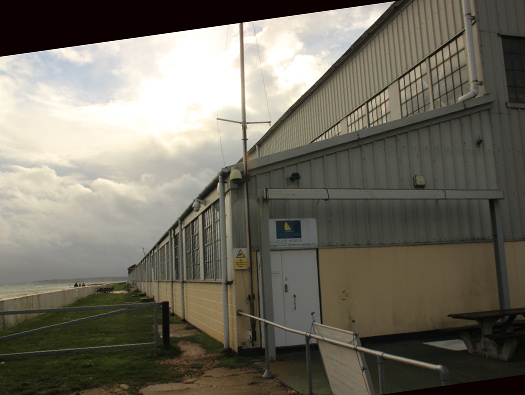
2018
Information
RAF Calshot
Details
76 - 'H' Shed - a Type 'F' seaplane shed - St & AsB
All down this side would be engineering, stores, pilots room, crew room, planning, etc. In wartime a hive of activity.

1935 Fleet Air Arm Conversion Course at RAF Calshot. Top row left to right Sgt. Joe Lane, PO Beck, PO Jurdwine [sic], PO Hards [sic], PO West.

Ground crew at Calshot.
RAF Calshot
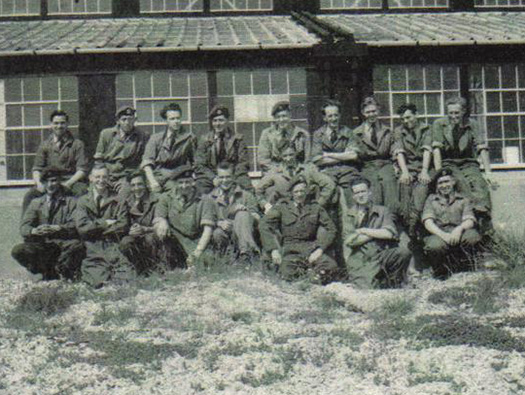
50's/60's
Information
RAF Calshot
Details
76 - 'H' Shed - a Type 'F' seaplane shed - St & AsB
All National Service lads doing their two year stint in the airforce, sitting on the sea wall in front of the hangar.
With the war ended in 1945 Calshot slowed down like all operational units. But 1946 and the Berlin Air Lift started due to the Russians closing the land route. So Sunderland's were used to carry food into the city with over a 1000 sorties, using the large Havel lake buy the Grunewald.

Sunderland flying boats supported the Berlin Airlift.

Routes into Berlin.
RAF Calshot

2006
Information
RAF Calshot
Details
76 - 'H' Shed - a Type 'F' seaplane shed - St & AsB
The north side with 72 the slipway running to the left.
On 1 April 1961, the RAF station finally closed. The marine craft unit was transferred to RAF Mount Batten.
RAF Calshot

2006
Information
RAF Calshot
Details
76 - 'H' Shed - a Type 'F' seaplane shed - St & AsB
Base of the winch and the winch house.

Plan.

22 the Hangar, the yellow square the winch house and then 72 the Slipway.

RAF winch shed.

RAF seaplane winch.
RAF Calshot

2006
Information
RAF Calshot
Details
This is by the winch shed and I have no idea what it is but I think it maybe a base for a pulley for the steel strop to run around from the winch to the seaplane.

This is how it may have worked??
RAF Calshot


2006 ------------------------------------------------------------------------ 1930's IWM (H(AM) 146)
Information
RAF Calshot
Details
72 - Slipway - PC Cal - 501.
The large slipway.
1939 and war started, and there was an increase in trainees to learn the use of marine craft. Also the maintenance and modification of flying boats in the anti-submarine role. Later No.201 Sqn flew in and started anti-submarine patrols.
A Fairey IIIF seaplane being moved down a slipway at Calshot.

Slipway in use.

The slipway.

Plan.

No. 201Sqdn (Flying Boat) RAF.

A 201Sqdn Sunderland attacking a U-Boat.

Sunderland nose section.
RAF Calshot


2018 ------------------------------------------------------------------- 1930's
Information
RAF Calshot
Details
70 - Castle, - Camera Obscurer & Telephone Exchange - Stone.
The Castle built for Henry VIII to defend the port of Southampton. Here it was used for, flying control, offices, telephone exchange, camera obscurer and also as a defence site for the Spit.
A camera Obscurer was a simple synthetic way of accurately measuring aircraft bomb aiming. The pilot would fly at the target (Obscurer) and when he thought it the correct time to drop the bomb, he would activate a light. The light would shine through the obscurer onto a table top with the centre as the target. The flash would shine onto the table and an airman would mark off how accurate the pilot had been.

Camera Obscurer.

The way the RAF used a camera Obscura.

PBX Private Branch Exchange telephone system.
RAF Calshot

2006
Information
RAF Calshot
Details
70 - Castle - Camera Obscurer & Telephone Exchange - Stone.
I do like the way the RAF plan states that the Castle was built in Stone. Typical detail of a Civil Servant in the Air Ministry.

Henry VIII.
RAF Calshot

2006
Information
RAF Calshot
Details
70 - Castle - Camera Obscurer & Telephone Exchange - Stone.
Probably a WW1 defence gun on the tower.

RAF Regiment defence troops.
RAF Calshot

2006
Information
RAF Calshot
Details
67 - 'E' Shed & Drying Rooms T & Ci - 14451 (possibly 144/16)
This area has now been taken up by the coastguard and RNLI.

RNLI Yarmouth class boat.

RNLI inshore boat.

Air-Sea.
RAF Calshot

2006
Information
RAF Calshot
Details
67 'E' Shed & Drying Rooms T &Ci 14458
(possibly 144/16)
And this is how it looked with the 'E' Shed, a General Service Shed with one opening on he west side.

'E' Shed closed end.

'E' Shed with Esavian sliding doors.

An advert for Esavian Bi-folding doors that were fitted to this hangar..

The Belfast Truss principle.
RAF Calshot

2006
Information
RAF Calshot
Details
Type 'F' Admiralty Seaplane Shed 100ft span x 200ft length and 28ft high. Made originally with steel supports and corrugated iron cladding. This is a lovely example sitting very proud on the Spit.

End view of an 'F' Shed.

An 'F' Shed under construction.
RAF Calshot

2006
Information
RAF Calshot
Details
77 - 'F' Shed & Offices - St&Ci
Schneider hangar completely re clad now.
RAF Calshot

2006
Information
RAF Calshot
Details
77 - 'F' Shed & Offices - St&Ci
The Z brassing along the front to strengthen the front face as there are no uprights allowing a full width opening. I have superimposed a Curtiss H.12 which has a span of 92 ft 8 1/2 inches. The hangar is 200ft wide.
1961 the RAF left and by 1964 Hampshire CC bought the lease on the land to turn it into an activity centre.

Supermarine S5 flight testing at Calshot one month prior to 1927 Schneider Trophy race at Venice.

1929 Schneider Trophy Race scoreboard.
RAF Calshot

2006
Information
RAF Calshot
Details
This is a lovely 1913/14 Belfast Truss ARS shed.
50 - Technical Store T - &Ci 31611/13ARS - Aircraft Repair Shed.

This hangar was built for the Sopwith Bat Boat plane.
RAF Calshot

2006
Information
RAF Calshot
Details
50 - Technical Store - T&Ci - 31611/13
I feel its dimensions are a bit lower than the 20ft height given for most ARS sheds.

How the roof works.

This is a standard ARS shed and it does look a lot higher.
RAF Calshot

2006
Information
RAF Calshot
Details
50 - Technical Store - T&Ci - 31611/13
Looking up into the skylights.
RAF Calshot

2006
Information
RAF Calshot
Details
50 - Technical Store - T&Ci - 31611/13
They do look half doors?? also if I remember the floor is a timber floor and not earth or concrete. Originally they could have been made with just a hard earth floor, but later most had concreted ones.

This is a full height door at RAF Old Sarum.
RAF Calshot

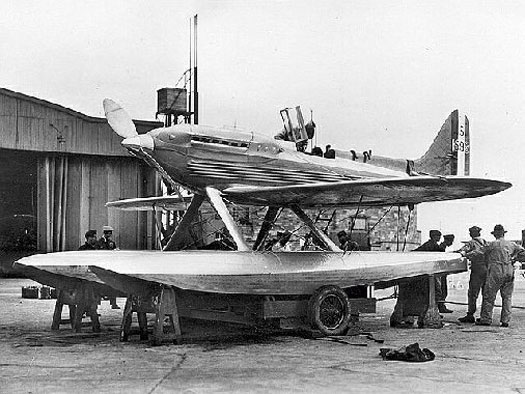
2006 -------------------------------------------------------------------------- 1931
Information
RAF Calshot
Details
50 - Technical Store - T&Ci - 31611/13
Post 1945 and ASWDU arrive. (Anti-Submarine Development Unit). Also 235 OCU. (Operational Conversion Unit).
The Supermarine S.6B is a British racing seaplane developed by R.J. Mitchell for the Supermarine company to take part in the Schneider Trophy competition of 1931. The S.6B marked the culmination of Mitchell's quest to "perfect the design of the racing seaplane" and represented the cutting edge of aerodynamic technology for the era. (Wiki).
RAF Calshot

2006
Information
RAF Calshot
Details
I cannot find any details of this building yet.
16 September 1946 to 16 February 1949 No.230 Sqn arrived with Sunderland Mk. V.
RAF Calshot

2006
Information
RAF Calshot
Details
But it does have a nice emblem on the wall.
RAF Calshot

2006
Information
RAF Calshot
Details
It may even out date the camp.
RAF Calshot

2006
Information
RAF Calshot
Details
Along here were a row of houses/coastguard cottages.
RAF Calshot
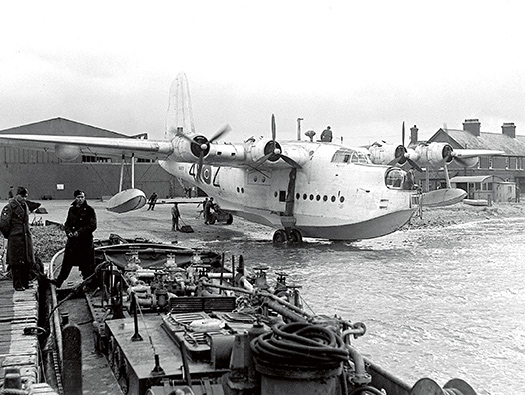
WW2
Information
RAF Calshot
Details
This is Short Sunderland GRV RAF 230Sqn 4XZ VZ577 during engine tests. You can see the Coastguard cottages behind the Sunderland's right wing.
Also not the refueling barge alongside the pier.

Engine change.
RAF Calshot

1953
Information
RAF Calshot
Details
The Princess Flying Boats
Post war and these were to be the last thing in air transport comfort, huge seaplanes with a passenger capacity of 105. Only one Princess ever flew, for just under 98 hours of testing. The other two were completed but quickly mothballed, since BOAC had already abandoned flying boats nearly two years earlier. Saunders-Roe promoted the SR.45 as a long-range troop carrier, but the British had no need, since they were giving up their east-of-Suez empire. NASA briefly thought of buying a Princess to carry Saturn V rockets from Huntsville, Alabama, to Cape Canaveral, Florida, and the U.S. Navy entertained the idea of having Convair re-power the boats with experimental nuclear reactors. Neither notion panned out. The three Princesses, their airframes having corroded while in storage, were scrapped by 1967.

Roy Nockolds c1950.

Flight deck.
RAF Calshot

2006
Information
RAF Calshot
Details
Looking back at the Spit.
After flying stopped No.238 M.U. (Maintenance Unit) for marine craft stayed here until closure 1st April 1961.
RAF Calshot
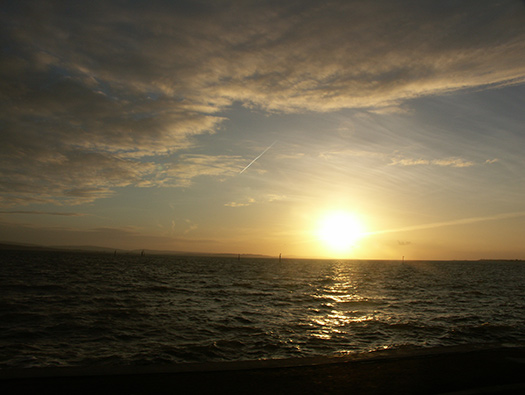
2006
Information
RAF Calshot
Details
 Norway (coming soon!)
Norway (coming soon!)
 France
France
 Great Britain
Great Britain




















































































































































































100.jpg)



























































